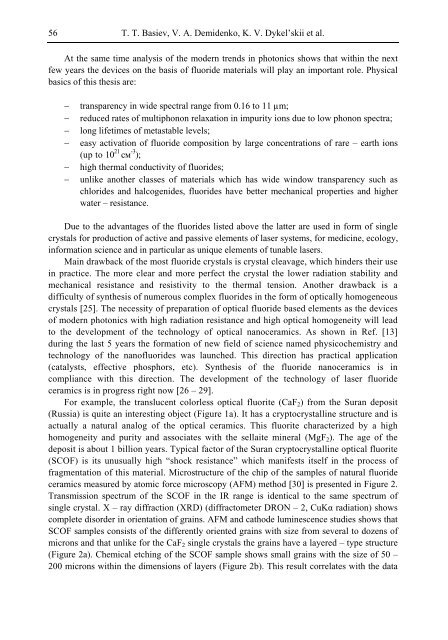Developments in Ceramic Materials Research
Developments in Ceramic Materials Research
Developments in Ceramic Materials Research
You also want an ePaper? Increase the reach of your titles
YUMPU automatically turns print PDFs into web optimized ePapers that Google loves.
56<br />
T. T. Basiev, V. A. Demidenko, K. V. Dykel’skii et al.<br />
At the same time analysis of the modern trends <strong>in</strong> photonics shows that with<strong>in</strong> the next<br />
few years the devices on the basis of fluoride materials will play an important role. Physical<br />
basics of this thesis are:<br />
− transparency <strong>in</strong> wide spectral range from 0.16 to 11 µm;<br />
− reduced rates of multiphonon relaxation <strong>in</strong> impurity ions due to low phonon spectra;<br />
− long lifetimes of metastable levels;<br />
− easy activation of fluoride composition by large concentrations of rare – earth ions<br />
(up to 10 21 см -3 );<br />
− high thermal conductivity of fluorides;<br />
− unlike another classes of materials which has wide w<strong>in</strong>dow transparency such as<br />
chlorides and halcogenides, fluorides have better mechanical properties and higher<br />
water – resistance.<br />
Due to the advantages of the fluorides listed above the latter are used <strong>in</strong> form of s<strong>in</strong>gle<br />
crystals for production of active and passive elements of laser systems, for medic<strong>in</strong>e, ecology,<br />
<strong>in</strong>formation science and <strong>in</strong> particular as unique elements of tunable lasers.<br />
Ma<strong>in</strong> drawback of the most fluoride crystals is crystal cleavage, which h<strong>in</strong>ders their use<br />
<strong>in</strong> practice. The more clear and more perfect the crystal the lower radiation stability and<br />
mechanical resistance and resistivity to the thermal tension. Another drawback is a<br />
difficulty of synthesis of numerous complex fluorides <strong>in</strong> the form of optically homogeneous<br />
crystals [25]. The necessity of preparation of optical fluoride based elements as the devices<br />
of modern photonics with high radiation resistance and high optical homogeneity will lead<br />
to the development of the technology of optical nanoceramics. As shown <strong>in</strong> Ref. [13]<br />
dur<strong>in</strong>g the last 5 years the formation of new field of science named physicochemistry and<br />
technology of the nanofluorides was launched. This direction has practical application<br />
(catalysts, effective phosphors, etc). Synthesis of the fluoride nanoceramics is <strong>in</strong><br />
compliance with this direction. The development of the technology of laser fluoride<br />
ceramics is <strong>in</strong> progress right now [26 – 29].<br />
For example, the translucent colorless optical fluorite (CaF2) from the Suran deposit<br />
(Russia) is quite an <strong>in</strong>terest<strong>in</strong>g object (Figure 1a). It has a cryptocrystall<strong>in</strong>e structure and is<br />
actually a natural analog of the optical ceramics. This fluorite characterized by a high<br />
homogeneity and purity and associates with the sellaite m<strong>in</strong>eral (MgF2). The age of the<br />
deposit is about 1 billion years. Typical factor of the Suran cryptocrystall<strong>in</strong>e optical fluorite<br />
(SCOF) is its unusually high “shock resistance” which manifests itself <strong>in</strong> the process of<br />
fragmentation of this material. Microstructure of the chip of the samples of natural fluoride<br />
ceramics measured by atomic force microscopy (AFM) method [30] is presented <strong>in</strong> Figure 2.<br />
Transmission spectrum of the SCOF <strong>in</strong> the IR range is identical to the same spectrum of<br />
s<strong>in</strong>gle crystal. X – ray diffraction (XRD) (diffractometer DRON – 2, CuKα radiation) shows<br />
complete disorder <strong>in</strong> orientation of gra<strong>in</strong>s. AFM and cathode lum<strong>in</strong>escence studies shows that<br />
SCOF samples consists of the differently oriented gra<strong>in</strong>s with size from several to dozens of<br />
microns and that unlike for the CaF2 s<strong>in</strong>gle crystals the gra<strong>in</strong>s have a layered – type structure<br />
(Figure 2a). Chemical etch<strong>in</strong>g of the SCOF sample shows small gra<strong>in</strong>s with the size of 50 –<br />
200 microns with<strong>in</strong> the dimensions of layers (Figure 2b). This result correlates with the data
















